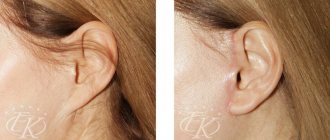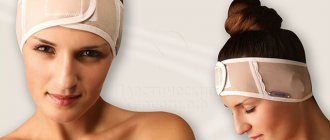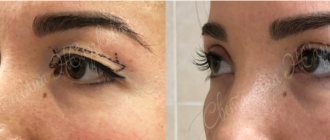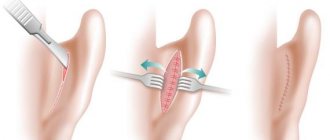Indications and contraindications for otoplasty
Otoplasty is a plastic surgery, thanks to which the doctor can model the desired, anatomically correct shape of the ears for defects of various directions. The main indications for surgical correction of the ears are:
- the need to form a natural-looking antihelix of the auricle;
- asymmetrical and non-standard ear shape;
- protruding ears;
- deformations of cartilage tissue that can only be eliminated surgically;
- absence of the auricle (aplasia);
- aplasia of the ears caused by trauma, accident, accident;
- damage to the auricle caused by burns from acid, fire, explosives;
- disproportionate size of the ears in relation to the face;
- bifurcation, inversion of the lobe or wrinkling of soft tissues.
Otoplasty allows you to make the ears beautiful, aesthetically attractive and ideal.
Indications
Otoplasty is performed if the patient wants to eliminate protruding ears, asymmetry of the shells or other external defects. Today, young people often turn to surgeons who want to sharpen the upper tip of the shell or change any parameters of the lobe.
The main indications also include:
- Small and large ears
- Birth defects of various types (protruding ears, protruding ear, “macaque ear”, etc.)
- Acquired defects and consequences of injuries (ruptures and deformations, wearing tunnels, etc.)
Otoplasty, like any other type of surgical intervention, has a number of contraindications:
- diseases of the cardiovascular system;
- diabetes;
- cancer or sexually transmitted diseases;
- exacerbation of chronic diseases;
- blood clotting disorder;
- ear diseases (chronic and infectious);
- high or low blood pressure.
If otoplasty is planned for a woman, then contraindications to surgical intervention are menstruation, pregnancy and lactation.
To avoid complications and risks during and after otoplasty, the plastic surgeon conducts a face-to-face consultation with the patient, collects anamnesis and sends him for tests. In particular, the plastic surgeon before traditional and laser otoplasty:
- carries out targeted photography of the ears;
- measures the size of each ear;
- determines the relationship between the ears and the proportions of the face;
- analyzes possible asymmetry of the auricles, earlobes, helix or antihelix.
Based on the data obtained, a model of the ears is created, which the plastic surgeon will use during otoplasty.
In preparation for surgery, the patient should:
- visit a therapist and specialized specialist if you have chronic diseases;
- undergo fluorography and ECG;
- pass a general clinical analysis of urine and blood;
- do a biochemical blood test to determine the level of glucose, bilirubin, urea and creatinine in the blood;
- do a blood test to study coagulation (coagulogram);
- determine blood group and RH factor through analysis;
- do a blood test for RW, HIV, hepatitis.
Correction of ear asymmetry
Asymmetry of the ears is quite common. If the patient considers the asymmetry to be too noticeable, then the most effective solution would be to perform otoplasty, correcting the proportionality of the ears.
If the patient is dissatisfied with the shape of only one ear, then, depending on the professional opinion of the surgeon and the desire of the patient, otoplasty can be performed on both one and two ears - to achieve maximum symmetry.
Plastic surgery is also performed for congenital hypertrophy of the earlobes (disproportion between the earlobes and the auricle), a rare but also common problem.
Types of otoplasty
Among specialists in the field of plastic surgery, it is customary to distinguish several main types of plastic surgery on the ears, which depend on the purpose of plastic surgery, the technique and method of correction, the complexity of the surgical intervention and other factors.
Otoplasty, depending on the purpose of the operation, is divided into:
- Reconstructive ear surgery
– this surgical correction allows you to eliminate congenital deformities of the ears, restore the missing part of the cartilage tissue or the entire auricle. To do this, the plastic surgeon uses autografts - a section of rib cartilage and the patient's soft tissue, which guarantees almost 100% survival and minimal risks of rejection. Reconstructive otoplasty is a more complex surgical method than aesthetic ear surgery. Therefore, restoration of the auricle takes more time, and the correction itself is carried out only by experienced surgeons. In total, ear reconstruction can last from 2 months to six months, which depends on the complexity of the defect, the patient’s health and many other factors. In most cases, reconstructive otoplasty takes place in 2 successive stages: the plastic surgeon creates a special “pocket” under the skin where cartilage will be placed in the future; - The second stage of the operation is the direct formation of the outer ear.
is a surgical intervention that allows the doctor to reduce the unaesthetic size of the ear and change the shape of the auricle, give smooth contours, remove protruding ears, correct bifurcation of the lobe, etc.
Based on the method of performing the operation, otoplasty is divided into:
- Traditional ear surgery
, during which the plastic surgeon uses a scalpel. - Laser otoplasty
, which today is more popular in comparison with the classical surgical technique. - Seamless ear otoplasty
. During the operation, the plastic surgeon corrects the shape of the auricle, modeling a new type of ear. This can be done due to the excellent flexibility of cartilage tissue. During plastic surgery, the doctor makes an incision behind the ear and then removes excess skin and cartilage. There are no sutures placed on the incision. - Suture otoplasty.
Plastic surgeons use 2 types of suture otoplasty:
Mustard
. During surgery, the surgeon makes a long incision on the back of the ear and then stitches it. It is the suture material that promotes the bending of cartilage tissue, resulting in the formation of a beautiful fold of the antihelix of the auricle. - Furnas
. The surgeon excises a piece of skin behind the ear, and then sutures the cartilage tissue to the temporal bone.
. This method of performing ear surgery is used if the surgeon’s patient is a child. During surgery, the plastic surgeon removes skin. The cartilage tissue is bent back, after which it is secured in the desired position using permanent sutures.
. This method is the least traumatic, as it does not involve making cuts on the skin. A plastic surgeon performs aesthetic plastic surgery of the ears through small punctures in the skin behind the ears.
According to the degree of complexity, ear otoplasty is divided into:
- Otoplasty of the first degree of complexity
. In this case, we are talking about subtle aesthetic flaws in the relief of the ears. During plastic surgery, the surgeon removes excess cartilage tissue, which allows the ears to be given the desired shape. - Otoplasty of the second degree of complexity
. In a patient, the doctor can detect smoothness of the helix and a deep distance of the auricle from the skull. During surgical correction, the plastic surgeon forms the folds of the antihelix. - Otoplasty of the third degree of complexity.
The most difficult type of surgical correction. Plastic surgery on the ears involves the fact that the surgeon will carry out a serious correction of the cartilage tissue during the procedure, since the patient has been diagnosed with disturbances in the anatomical structure of the auditory organ.
Otoplasty can be performed for aesthetic reasons. Therefore, the operation is classified according to the purpose of surgical correction of the ears. Otoplasty is indicated if:
- The patient has severe protruding ears
. In most cases, plastic surgeons use a suture correction method during surgery. - The patient's earlobe is injured or its size is excessive
. The duration of the operation depends on the complexity of the patient’s ear injury. When reducing the size of the lobe, the surgeon excises excess tissue and forms a new shape of the lobe. - The patient has a stretched earlobe due to a tunnel
. One of the most difficult types of otoplasty, since during the procedure the surgeon must completely close the tunnel and excise excess stretched skin. - The patient wants to have “elf ears” done
. This type of operation is very complex, as it involves changing the shape of the cartilage from semicircular to oblong with a pointed tip.
Plastic surgeons also divide aesthetic plastic surgery of the ears according to the number of operations:
- Primary surgical correction
, when the patient comes for the first time for a consultation with a plastic surgeon in order to eliminate an aesthetic defect in the ears. - Repeated otoplasty.
It is performed on the patient if the result of aesthetic correction of the ears by surgical method is not satisfactory. In most cases, repeated plastic surgery is performed for asymmetry of the ears, if a keloid scar has formed after surgery, or if the effect of the aesthetic procedure is insufficient.
Traditional otoplasty - description of the technique
This type of ear surgery involves cutting the skin and cartilage using a surgical scalpel. The operation lasts about 1.5 hours. Anesthesia is used, less often local anesthesia.
In the first stage of the operation, the plastic surgeon uses a scalpel to make an incision in the skin behind the auricle. In some cases, an incision is required on the front of the ear - in this case, the surgeon uses a scalpel to make them in the natural folds of the ear, making them invisible to others. Next, the doctor carefully separates the skin from the perichondrium. During the procedure, the surgeon removes a portion of the skin on the back of the ear and then bends the cartilage back. Finally, the doctor applies sutures that fix the new position of the cartilage tissue. After plastic surgery, the doctor puts a fixing bandage on the head, which allows you to fix the ears in a new position.
In adult patients, surgical correction can be performed under local anesthesia; in the case of children, if laser otoplasty is not possible and the plastic surgeon opts for the traditional approach, general anesthesia is usually used. How much does traditional ear otoplasty cost? The average price of plastic surgery in Moscow is 70 thousand rubles.
Laser otoplasty - progress of the operation
The laser method is a more expensive way to correct the shape of the ears. The operation lasts only 30 minutes and is performed under local anesthesia. There is practically no pain, which is why laser otoplasty is popular among children. All cuts are made using a laser scalpel, and, therefore, there is much less blood than with the traditional method. The rehabilitation period is also much shorter.
Rehabilitation after laser otoplasty takes place in a short time. You can evaluate the final result of protruding ear correction within a week. Incisions made with a laser scalpel heal very quickly. To eliminate pain in the first days, you should take analgesics.
In order to reduce the risk of any complications, it is necessary to strictly adhere to all doctor’s recommendations after surgical correction of the ears. In particular, you should wear a special multi-layer bandage that will protect your ears from mechanical stress and adverse factors.
Correction of protruding ears in adults and children
Correcting protruding ears is one of the most common reasons for visiting a plastic surgeon. Prominent ears are not considered a medical pathology, so ear plastic surgery in this case is purely aesthetic.
Severe protruding ears can become the basis of psychological trauma and the cause of ridicule from others. An important feature of plastic surgery for protruding ears is the minimal level of intervention during surgery. The guaranteed safety of the operation allows otoplasty to be performed on a child.
Ear plastic surgery in children at EMC is performed from the age of 7, when the auricles are almost completely formed. The healing process goes quite quickly, the ears after otoplasty look natural and do not bother the child, after the healing process is completed the child will not even remember about the operation. Even upon closer inspection, no one will notice the small strip of cosmetic seam behind the auricle.
Benefits of laser otoplasty
If we talk about traditional and laser otoplasty, the advantages of laser ear surgery are undeniable:
- high precision of beam exposure to cartilage and soft tissues, thanks to which the doctor can achieve smooth lines;
- under the influence of a laser beam, cartilage becomes more plastic, which facilitates the correction process;
- small vessels that are damaged during otoplasty are immediately cauterized with a laser beam, which prevents bleeding;
- the risks of wound infection during otoplasty are minimal, since the laser has a bactericidal effect;
- the duration of laser correction of the auricle is reduced by 20–30 minutes;
- the rehabilitation period passes more easily and unnoticed by the patient.
It should be remembered that otoplasty using laser equipment is more expensive than the traditional method of ear surgery. To achieve optimal results from ear plastic surgery, each plastic surgeon selects the surgical technique for the patient during an in-person consultation. It is impossible to resolve such an issue in absentia.
Rehabilitation period
In most cases, after ear surgery, the patient will experience some pain. To reduce discomfort, the plastic surgeon prescribes painkillers to the patient. During the rehabilitation period after laser or traditional otoplasty you cannot:
- wet your hair for a week;
- exercise for 2 months;
- visit the bathhouse, sauna and solarium for 1.5-2 months;
- expose your ears to hypothermia.
After aesthetic ear surgery, the patient needs to have postoperative sutures treated. An alcohol solution of calendula is suitable for this, which should be used once a day. Processing time: 10 days.
For 1 month after ear otoplasty or earlobe plastic surgery, it is important to wear a pressure bandage. For the first 14 days after surgical correction of the ears, the elastic bandage should be worn constantly, then it should be worn only during sleep.
With any medical intervention there is a chance of complications, but in this case it is very low - 0.5-1%. In case of complications, the Maxim Aleksandrovich Osin plastic surgery clinic will always provide the necessary assistance.
Early complications after surgical correction of the ears include:
- formation of epidermal blisters due to allergies to medications and anesthetics;
- complications after anesthesia, most often observed in children and adolescents;
- inflammation of soft tissues, accompanied by pain, swelling, redness;
- development of phlegmon;
- inflammation of the perichondrium.
Late undesirable consequences of otoplasty are:
- cutting through the sutures that were placed on the cartilage during surgery;
- keloid or hypertrophic scars;
- necrotic changes in cartilage;
- lack of results from aesthetic correction of the ears;
- ear asymmetry;
- emphasized relief of cartilaginous structures, etc.
Laser and traditional ear otoplasty provide lifelong results. Even over a long period of time, the ears will not return to their original shape. In case of complications, hearing acuity is not lost.
Preparing for surgery
Before undergoing otoplasty, you must undergo a mandatory examination, including blood tests, urine tests, sugar levels, an ECG, as well as a mandatory consultation with an anesthesiologist. You can undergo all necessary tests and preoperative examinations at the EMC clinic.
Before surgery, it is prohibited to take aspirin and medications containing it. A week before surgery, avoid salty, spicy, and smoked foods.
10 days before surgery you must refrain from smoking.
At what age can you have ear surgery?
Today, the optimal period for aesthetic otoplasty is considered to be childhood - 6-7 years. This is due to the fact that at this time the child is not yet attending school, which means he will not suffer psychologically from children’s ridicule about his protruding ears, aesthetic defects in the auricles, and earlobes. It is not recommended to perform laser otoplasty in children under 6 years of age, which is due to the final formation of the shape of the auricle by this age. But at the same time, a plastic surgeon can perform surgical correction in young patients, if there are indications for this.
If you or your child needs otoplasty, study the prices and reviews of plastic surgery on our website. Photos of patients after surgical correction of the ears are real and published with the permission of the clients.
FAQ
What tests need to be done before otoplasty?
Before the operation, you need to pass the following list of tests: a general blood test with a leukocyte formula, a general urine test, an electrocardiogram (ECG) and a chest x-ray.
At what age can children have otoplasty?
Ear plastic surgery in children at EMC is performed from the age of 7, when the auricles are almost completely formed.
How long to wear a bandage after otoplasty?
A post-operative bandage to help secure the ears should be worn for about a week after surgery.
How long do your ears hurt after surgery?
Pain in the ear area may occur for 10-14 days after surgery. To eliminate possible pain, the doctor prescribes analgesics.
Ear plastic surgery: prices in Moscow
How much does ear plastic surgery cost? The cost of surgical correction of the ears is calculated individually for each patient by a plastic surgeon after examining the ears. Average prices for otoplasty depend on the technique of aesthetic surgery:
- traditional ear otoplasty – from 50 to 75 thousand rubles;
- laser otoplasty – from 60 to 80 thousand rubles;
- earlobe correction – from 30 to 40 thousand rubles;
- reconstruction of the auricle – from 200 thousand rubles.
The cost of otoplasty is quite low, so aesthetic and reconstructive surgery has become available to all patients who have flaws in appearance.
Advantages of the EMC Clinic
EMC Aesthetic Clinic is a leading Moscow clinic in the field of cosmetology and plastic surgery. EMC has been providing medical services for more than 27 years, strictly observing international protocols and representing the highest level of medicine.
The high professional skills of EMC specialists allow us to deal with the most complex cases and show amazing results in our work. The appearance of the ears and hearing acuity do not always radically change life, but they always affect its quality. Correction, reconstructive restoration of the auricles, restoration of hearing function, EMC’s task is to help its patients in any situation at the highest level of medical capabilities.










